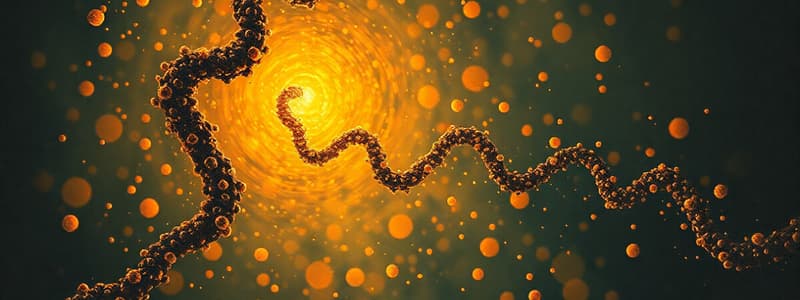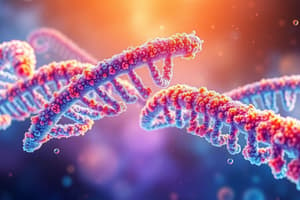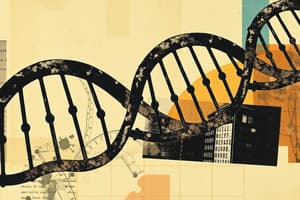Podcast
Questions and Answers
What is the role of exons in a gene?
What is the role of exons in a gene?
Introns are coding segments of DNA that are translated into proteins.
Introns are coding segments of DNA that are translated into proteins.
False
Where does transcription occur in eukaryotic cells?
Where does transcription occur in eukaryotic cells?
Nucleus
The coding strand of DNA is also known as the _____ strand.
The coding strand of DNA is also known as the _____ strand.
Signup and view all the answers
Match the following molecules with their roles in protein synthesis:
Match the following molecules with their roles in protein synthesis:
Signup and view all the answers
What is the primary function of helicases during DNA replication?
What is the primary function of helicases during DNA replication?
Signup and view all the answers
Semi-conservative replication results in two DNA molecules that are entirely new.
Semi-conservative replication results in two DNA molecules that are entirely new.
Signup and view all the answers
What are the two types of strands present after DNA replication?
What are the two types of strands present after DNA replication?
Signup and view all the answers
DNA _____ catalyzes the synthesis of new complementary DNA strands during replication.
DNA _____ catalyzes the synthesis of new complementary DNA strands during replication.
Signup and view all the answers
Match the following enzymes to their functions during DNA replication:
Match the following enzymes to their functions during DNA replication:
Signup and view all the answers
Study Notes
DNA & Proteins: Language of Life
- DNA is a double helix formed from two strands wrapped around each other.
- The backbone of each strand is made of alternating sugar and phosphate molecules.
- Attached to each sugar molecule is one of four bases: adenine (A), thymine (T), guanine (G), and cytosine (C).
- Each base pairs with its complementary base on the other strand (A with T, and G with C).
- A gene is a unique sequence of nucleotides that codes for a functional protein or an RNA molecule.
- Exons are coding segments of DNA, while introns are non-coding segments.
- Both exons and introns are transcribed, but only exons are translated to form a polypeptide in eukaryotes.
- Protein synthesis involves transcription and translation.
- Transcription occurs in the nucleus, where a gene's DNA sequence is copied into mRNA.
- Translation occurs at the ribosomes, where mRNA's instructions are used to assemble amino acids into a polypeptide chain.
- DNA, mRNA, tRNA, and rRNA all play roles in transcription and translation.
- DNA codons, RNA codons, anticodons, and amino acids are related.
- DNA strands are directional, read 5' to 3'.
- Genes make up approximately 10% of an organism's DNA.
- Gene sequences determine traits, like eye color.
- Genes code for proteins via mRNA or structural RNA (tRNA and rRNA).
- All genes initially code for RNA; if mRNA is coded for, it produces a polypeptide (protein).
- A DNA molecule contains instructions for hundreds or thousands of proteins.
- Ribosomal RNA (rRNA) associates with proteins to form ribosomes, the site of protein synthesis.
- Transfer RNA (tRNA) carries specific amino acids to the ribosomes during protein synthesis.
- Messenger RNA (mRNA) carries the genetic information from DNA to ribosomes for translation.
- A polypeptide is a chain of amino acids. Amino acids are the building blocks of proteins.
- Three DNA bases form a codon which specifies a particular amino acid.
- There are 20 amino acids encoded by 64 possible codons. Some codons are "stop" signals.
- The DNA strand used as a template during transcription is the non-coding strand.
- The other strand containing the coding sequence is referred to as the coding strand.
- mRNA is modified after transcription to remove non-coding regions.
- Introns are non-coding sequences within genes that are spliced out before translation. Exons, coding sequences, are joined after splicing.
DNA Replication
- Before a cell divides, it must replicate its DNA.
- DNA replication is semi-conservative, each new DNA molecule contains one old and one new strand.
- Enzymes like helicase unwind the DNA double helix.
- Free nucleotides pair with complimentary bases on the template strands.
- DNA polymerase joins free nucleotides, building new DNA strands.
- The process is completed when the DNA fully re-twists into two identical DNA molecules.
- Replication must be completed before cell division can occur.
- Several enzymes are involved in DNA replication including DNA polymerases, helicases, primases, and ligases, and topoisomerases.
Protein Synthesis: Overview
- Transcription is the process of making mRNA from DNA.
- Translation is the process of making proteins from mRNA.
- During transcription, DNA's code is copied into mRNA.
- mRNA moves to the cytoplasm to be translated.
- mRNA is translated into a protein at the ribosome.
- tRNA carries amino acids to the ribosome according to the mRNA's codons.
- Amino acids are bonded together to form a polypeptide chain, which folds into a functional protein.
Gene Expression: Introns and Exons
- Introns are intervening, non-coding DNA sequences within a gene.
- Exons are the coding sequences of a gene.
- Introns are removed from a pre-mRNA transcript (non-coding sequences).
- Exons are joined together to form a mature mRNA transcript (coding sequences).
Translation
- Ribosomes are the sites of protein synthesis, made of rRNA and proteins.
- mRNA feeds through the ribosome, with codons (3-base sequences) being read.
- tRNA molecules carry specific amino acids to the ribosome, matching their anticodons to the codons on the mRNA.
- Amino acids bond together to form a polypeptide chain.
- The process continues until a stop codon is reached on the mRNA.
- The chain then folds into a functional protein.
Studying That Suits You
Use AI to generate personalized quizzes and flashcards to suit your learning preferences.
Related Documents
Description
Test your knowledge on the roles of exons, introns, and various enzymes in DNA replication and transcription. This quiz covers essential concepts in molecular biology that are crucial for understanding gene expression and protein synthesis. Assess your grasp on the mechanisms that drive genetic processes.




